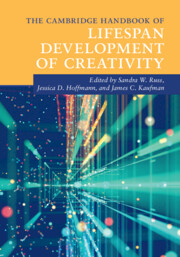Book contents
- The Cambridge Handbook of Lifespan Development of Creativity
- The Cambridge Handbook of Lifespan Development of Creativity
- Copyright page
- Dedication
- Contents
- Figures
- Tables
- Contributors
- Acknowledgments
- Introduction
- Part I Core Concepts of Lifespan Creativity Development
- Part II The Development of Creativity
- Part III Modes of Enhancement
- Part IV Environments and Contexts
- Part V Special Populations
- 23 The Development of Gifted and Talented Students’ Creativity in School Contexts
- 24 Creative Play in Children with Neurodevelopmental Disorders
- 25 Eminent Creators
- Epilogue: What Have We Learned?
- Index
- References
23 - The Development of Gifted and Talented Students’ Creativity in School Contexts
from Part V - Special Populations
Published online by Cambridge University Press: 19 November 2021
- The Cambridge Handbook of Lifespan Development of Creativity
- The Cambridge Handbook of Lifespan Development of Creativity
- Copyright page
- Dedication
- Contents
- Figures
- Tables
- Contributors
- Acknowledgments
- Introduction
- Part I Core Concepts of Lifespan Creativity Development
- Part II The Development of Creativity
- Part III Modes of Enhancement
- Part IV Environments and Contexts
- Part V Special Populations
- 23 The Development of Gifted and Talented Students’ Creativity in School Contexts
- 24 Creative Play in Children with Neurodevelopmental Disorders
- 25 Eminent Creators
- Epilogue: What Have We Learned?
- Index
- References
Summary
Although the development of creativity is an oft-stated goal for students, it is seldom infused into school curricula, nor are teachers explicitly trained on how to promote it within their classrooms, even in the context of selective programs. We have several goals for this chapter. The first is to describe our view of the current status of creativity education for advanced pre-university students, noting its minimal presence except in artistic domains. Second, we differentiate the concepts of gifted education and talent development, favoring the latter as the direction of the future for enhancing the role of creativity. Third, we address some challenges for applying creativity in the gifted and talented classroom.
Keywords
- Type
- Chapter
- Information
- The Cambridge Handbook of Lifespan Development of Creativity , pp. 497 - 511Publisher: Cambridge University PressPrint publication year: 2021



